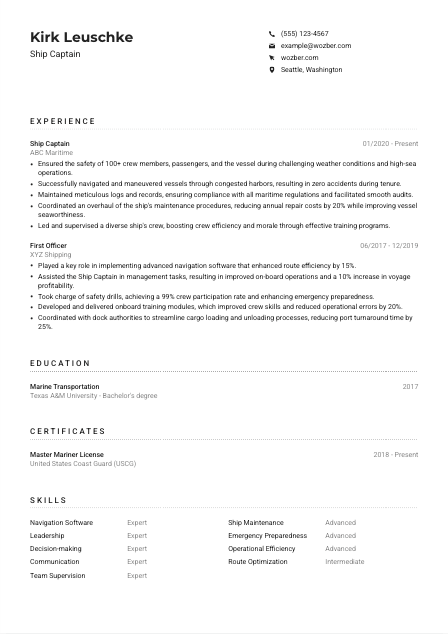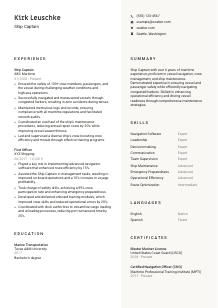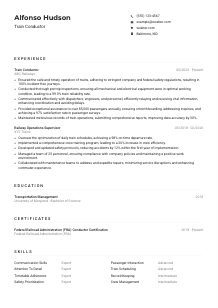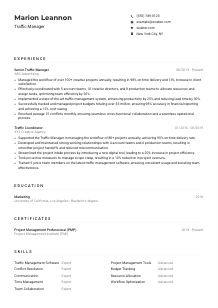Ship Captain CV Example
Commanding the seas, but your CV feels adrift? Anchor down with this Ship Captain CV example, charted with Wozber free CV builder. Discover how to harness your maritime leadership with job specifications, guiding your career voyage as confidently as you navigate treacherous waters!

How to write a Ship Captain CV?
Ahoy, aspiring Ship Captain! Ready to steady the helm of your career and set sail towards your dream job? Crafting a CV that cuts through the sea of applicants is your first voyage. Armed with Wozber's free CV builder, you're about to embark on a journey to create an ATS-compliant CV that highlights your strengths in the maritime world.
Each paragraph is a compass point guiding you through crafting a CV that echoes the tones of the sea and the specifics of a Ship Captain role. Let's navigate these waters together!
Personal Details
In the vast ocean of CVs, your personal details are the lighthouse guiding hiring managers to your shores. It's essential to tailor this section like a customized compass, ensuring it leads directly to you. Dive in as we chart the course.
1. Craft Your Name Like a Ship's Nameplate
Just as a ship is recognized by its name, so shall be your CV. Place your name prominently atop, ensuring it's the beacon that catches the eye. Use a font that's bold yet navigable, setting the course for the journey down your CV.
2. Position Title as Your Flag
Below your name, hoist your title — "Ship Captain." This acts like a flag, signaling your expertise and ambitions. It aligns with the job description, ensuring immediate relevance in the eyes of the recruiter navigating the pool of candidates.
3. Chart Your Contact Details
List your most reliable contact information, including a professional email and your phone number. Verify these for accuracy. For true course correction, ensure your LinkedIn profile (if included) mirrors the maritime leadership depicted in your CV. A link to a professional online portfolio or personal website can serve as an expanded deck for showcasing your career journey.
4. Anchor in the Required Harbor
The job description states a preference for candidates located in Seattle, Washington. Make sure your location is clearly visible, reassuring the hiring manager that you're anchored in the right port, eliminating any concerns about relocation.
5. Jettison Unnecessary Cargo
Leave out details like age, gender, or photo unless the job specifically requests them. This maritime voyage is about skills and experiences, not personal attributes that could muddle the waters with potential biases.
Takeaway
Your personal information section sets the sail for your journey. Craft it with precision, ensuring it's a beacon that guides hiring managers to see your potential. Remember, this is the crow's nest of your CV, offering a panoramic view of who you are professionally.





Experience
The chronicle of your seafaring exploits is the heart of your CV. Each role you've captained or crewed adds depth to your narrative. Let's plot the course through your professional waters, making each gotrten experience a testament to your command of the sea.
- Ensured the safety of 100+ crew members, passengers, and the vessel during challenging weather conditions and high‑sea operations.
- Successfully navigated and maneuvered vessels through congested harbors, resulting in zero accidents during tenure.
- Maintained meticulous logs and records, ensuring compliance with all maritime regulations and facilitated smooth audits.
- Coordinated an overhaul of the ship's maintenance procedures, reducing annual repair costs by 20% while improving vessel seaworthiness.
- Led and supervised a diverse ship's crew, boosting crew efficiency and morale through effective training programs.
- Played a key role in implementing advanced navigation software that enhanced route efficiency by 15%.
- Assisted the Ship Captain in management tasks, resulting in improved on‑board operations and a 10% increase in voyage profitability.
- Took charge of safety drills, achieving a 99% crew participation rate and enhancing emergency preparedness.
- Developed and delivered onboard training modules, which improved crew skills and reduced operational errors by 20%.
- Coordinated with dock authorities to streamline cargo loading and unloading processes, reducing port turnaround time by 25%.
1. Navigate Through the Job Description
Begin by identifying requirements directly linked to experiences. For a Ship Captain, it means emphasizing roles that demonstrated your maritime prowess, like successfully navigating through challenging conditions and leading diverse crews.
2. Set Your Course with Roles and Companies
List your experiences in reverse chronological order, starting with your most recent voyage at the helm or as a First Officer. The company name, your title, and the dates of your tenure are your coordinates here. This structure lets you lay out your professional journey in a clear, navigable manner.
3. Log Your Achievements
For each role, detail achievements that align with the job description. Did you enhance safety protocols? Did you streamline maintenance processes to bolster seaworthiness? These accomplishments show the scope of your command and your impact on vessel operations.
4. Quantify Your Maritime Deeds
Numbers are the nautical miles of your CV; they measure the distance you've led your crew. Quantifiable achievements, such as reducing repair costs by 20% or enhancing route efficiency by 15%, paint a vivid picture of your captaincy.
5. Sail Past Irrelevant Waters
Keep your professional history relevant to the Ship Captain role. While all sea tales are worth telling, your CV isn't the place for unrelated yarns. Focus on what makes you an exemplary candidate for this helm.
Takeaway
Your experience section is the map of your professional journey. Make it a detailed chart that guides hiring managers through your accomplishments. Show them the breadth of your seafaring prowess and how you've successfully navigated the challenges of the maritime world.
Education
The keel of your career, the education section underpins your professional journey. For a Ship Captain, this isn't just about where you've studied but also about showing that your foundational knowledge is as sound as a well-built hull. Let's hoist the sails on your educational background.
1. Mark the Course with Degree Requirements
Directly align your degree with the job description. A "Bachelor's degree in Marine Transportation or a related field" sets the course, indicating you have the necessary academic credentials to navigate the responsibilities of a Ship Captain.
2. Keep the Bearings Clear and Direct
Structure this section for easy navigation. List your degree, field of study, and the institution's name, followed by your graduation date. This straightforward approach ensures that hiring managers can quickly verify your educational qualifications.
3. Confirm Your Coordinates
If your degree title aligns perfectly with the job listing, such as the "Bachelor's degree in Marine Transportation," you're in clear waters. This direct match strengthens your candidacy by fulfilling a principal requirement.
4. Chart Relevant Courses
Though your voyage through education might have covered broad waters, highlighting specific courses can be advantageous. If you've taken specialized navigation or maritime leadership courses, mention these as they underscore your preparedness for the helm.
5. Signal Other Academic Achievements
Were you the captain of a collegiate crew team or involved in maritime studies beyond your degree requirements? While such details become less significant the further you sail from graduation, they can add color to your academic journey, especially for recent grads.
Takeaway
Your education section lays the foundation of your CV. It highlights the academic currents you've navigated to reach this point in your career. Ensure it's a testament to your readiness to take the helm as a Ship Captain, underpinned by a robust educational framework.
Certificates
Certificates are the badges of honor in your maritime career, signaling your dedication to continuous learning and mastery of the seas. For a Ship Captain, they validate your expertise and regulatory knowledge. Let's deck out your CV with your distinguished certifications.
1. Chart Your Certificate Holdings
Recall the job description's emphasis on a "Valid Master Mariner License from a recognized maritime institution." This credential is your passport to captaincy, evidence that you're not just at the helm but also fully certified to navigate and command.
2. Showcase Your Most Salient Certificates
In the sea of qualifications, prioritize certificates that directly relate to the Ship Captain role. It's about quality, not quantity. An up-to-date Master Mariner License should take precedence, being the keystone of your professional credentials.
3. Keep Your Documents Shipshape
If your certificates have a validity period, include the dates. This detail assures hiring managers that your qualifications are current, complying with the latest maritime regulations and technologies.
4. Pursue Continuous Credential Updates
The sea of knowledge is vast, with new navigational and safety protocols always on the horizon. Regularly refreshing your certifications keeps your skill set as current as the latest tide tables, ensuring you remain a competitive candidate.
Takeaway
Certificates are the lighthouses illuminating your expertise and readiness for the Ship Captain role. Ensure they are prominently displayed, guiding the way toward understanding your qualifications and standing in the nautical community.
Skills
Skills are the gusts that propel your CV forward, showcasing the practical application of your knowledge and experience. For a Ship Captain, these span both technical prowess and leadership finesse. Let's ensure your skills section catches the right winds.
1. Decode the Required Skills
Start by mapping out both the explicit and implicit skills mentioned in the job description. For instance, "strong leadership" and "proficiency in navigation software" are clear prerequisites, setting the course for what to highlight in your skills section.
2. Navigate Your Skill Inventory
Identify both hard and soft skills from your professional repertoire that align with the job listing. This list might include "emergency preparedness" or "decision-making," both critical competencies for a successful Ship Captain.
3. Chart a Clear and Efficient Course
Resist the urge to include an exhaustive list of skills. Instead, focus on those most relevant and impressive to a hiring manager. This precision ensures your skills section acts like a sextant, guiding readers to your most commendable qualities.
Takeaway
In the journey of your CV, skills are the winds that drive you forward. They demonstrate your ability to not only navigate but to lead, highlighting your readiness for the role of Ship Captain. Let each skill listed be a proud banner flying high on your mast.
Languages
In the naval realm of communication, the ability to speak multiple languages is like hoisting flags that signal your versatility and global readiness. Let's navigate through adding linguistic skills to your CV, ensuring they speak volumes of your capacity to command a diverse crew.
1. Scout the Linguistic Seas
First, determine if the job listing specifically highlights language requirements. The call for "proficiency in both spoken and written English" is your guiding star, prioritizing this language skill at the top of your list.
2. Fly the Flags of Your Linguistic Fleet
Even if not explicitly requested, additional languages can set you apart as a Ship Captain capable of navigating international waters or leading a multicultural crew. Position these languages as additional strengths, showcasing your global communication skills.
3. Rank Your Language Proficiency
Be clear and honest about your level of proficiency in each language, using well-understood terms such as "Native," "Fluent," "Intermediate," and "Basic." This transparency builds trust and gives an accurate portrayal of your communicative range.
4. Consider the Broad Reach of Your Voyages
Acknowledging languages beyond the required English can signal your capability for international commands or intercultural engagements, expanding the horizons of your employability and adaptability as a Ship Captain.
Takeaway
Languages are the colorful signals flown from your ship, announcing your ability to communicate in the diverse seas of the maritime industry. Each language you list enhances your image as a globally aware and adaptable Ship Captain, ready to command over any waters.
Summary
A compelling summary is like a lighthouse, guiding hiring managers through the fog towards the essence of your CV. Here, you encapsulate your sailing prowess, leadership on the high seas, and suitability for the Ship Captain role. Let's illuminate your path.
1. Chart the Waters
Begin by absorbing the key requirements and responsibilities from the job description. Reflect on how your career to date aligns with being a Ship Captain, ready to take on the helm and ensure the safety and efficiency of maritime operations.
2. Hoist Your Sail
Introduce yourself with a powerful opening line that anchors your profession and years of experience. This sets the tone, signaling strong leadership and a deep-seated passion for maritime navigation and crew management.
3. Signal Your Capabilities
Highlight your key skills and achievements, directly echoing the job requirements. Show your readiness to "ensure the safety of all crew members, passengers, and the vessel at all times," as well as your proficiency in "navigation software and equipment."
4. Keep It in Calm Waters
While it's tempting to flood this section with every detail, remember the summary is your beacon, not the entire lighthouse. Keep it concise, allowing just enough light to pique interest and guide them into the breadth of your CV.
Takeaway
Your summary is the flare shot into the night sky of your CV, capturing attention and leading the way forward. It succinctly signals why you're the ideal candidate for the Ship Captain position, shining a spotlight on your leadership and maritime expertise. Craft it to ensure that recruiters are compelled to embark on the voyage through your professional narrative.
Launching Your Ship Captain Journey
As you conclude this guide, equipped with the compass points to navigate your CV creation, remember that each section is a leg of your journey. Using Wozber's free CV builder, with ATS-friendly CV templates and the ATS CV scanner, you're well-prepared to create a CV that not only reaches the shores of potential employers but anchors firmly in their minds. Strike your colors high, for your voyage to winning that Ship Captain role is well underway!

- Bachelor's degree in Marine Transportation or a related field.
- Minimum of 5 years' experience as a First Officer or in a similar senior maritime role.
- Valid Master Mariner License from a recognized maritime institution.
- Strong leadership, decision-making, and communication skills.
- Proficiency in navigation software and equipment.
- Must be proficient in both spoken and written English.
- Must be located in Seattle, Washington.
- Ensure the safety of all crew members, passengers, and the vessel at all times.
- Navigate and maneuver vessels according to weather conditions and harbor regulations.
- Maintain logs, records, and other administrative duties as per maritime regulations.
- Manage ship maintenance and necessary repairs, ensuring vessel remains seaworthy.
- Coordinate and supervise the activities of the ship's crew.















